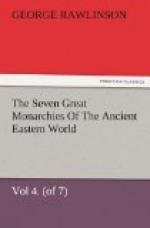Buffaloes were, it is probable, domesticated by the Babylonians at an early date. The animal seems to have been indigenous in the country, and it is far better suited for the marshy regions of Lower Babylonia and Susiana than cattle of the ordinary kind. It is perhaps a buffalo which is represented on an ancient tablet already referred to, where a lion is disturbed in the middle of his feast off a prostrate animal by a man armed with a hatchet. Cows and oxen, however, of the common kind are occasionally represented on the cylinders [plate IX., Fig. 4.], where they seem sometimes to represent animals about to be offered to the gods. Goats also appear frequently in this capacity; and they were probably more common than sheep, at any rate in the more southern districts. Of Babylonian sheep we have no representations at all on the monuments; but it is scarcely likely that a country which used wool so largely was content to be without them. At any rate they abounded in the provinces, forming the chief wealth of the more northern nations.
CHAPTEE III. THE PEOPLE.
“The Chaldaeans, that bitter and hasty nation.”—Habak. 1. 6.
The Babylonians, who, under Nabopolassar and Nebuchadnezzar, held the second place among the nations of the East, were emphatically a mixed race. The ancient people from whom they were in the main descended—the Chaldaeans of the First Empire—possessed this character to a considerable extent, since they united Cusbite with Turanian blood, and contained moreover a slight Semitic and probably a slight Arian element. But the Babylonians of later times—the Chaldaeans of the Hebrew prophets—must have been very much more a mixed race than their earlier namesakes—partly in consequence of the policy of colonization pursued systematically by the later Assyrian kings, partly from the direct influence exerted upon them by conquerors. Whatever may have been the case with the Arab dynasty, which bore sway in the country from about B.C. 1546 till B.C. 1300, it is certain that the Assyrians conquered Babylon about B.C. 1300, and almost certain that they established an Assyrian family upon the throne of Nimrod, which held for some considerable time the actual sovereignty of the country. It was natural that under a dynasty of Semites, Semitic blood should flow freely into the lower region, Semitic usages and modes of thought become prevalent, and the spoken language of the country pass from a Turanian or Turano-Cushite to a Semitic type. The previous Chaldaean race blended, apparently, with the new comers, and people was produced in which the three elements—the Semitic, the Turanian, and the Cushite—held about equal shares. The colonization of the Sargonid kings added probably other elements in small proportions, and the result was that among all the nations inhabiting Western Asia there can have been none so thoroughly deserving the title of a “mingled people” as the Babylonians of the later Empire.




